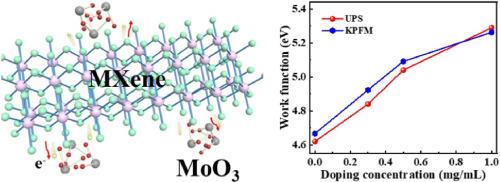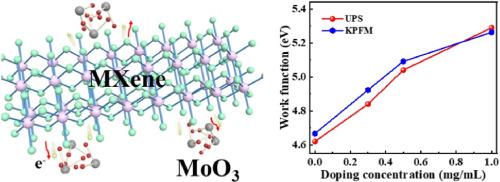光电应用中的电荷转移掺杂方案逐步调节Ti3C2Tx MXene的功函数
IF 9.7
2区 材料科学
Q1 MATERIALS SCIENCE, MULTIDISCIPLINARY
引用次数: 0
摘要
MXenes激发了人们对其迷人和可调节的材料特性的探索热情。调整它们的工作功能是开发基于mxene的电子和光电子器件的迫切需要。尽管如此,MXenes的表面终止相关材料特性使得在不改变其他基本材料特性的情况下离散地调整功函数变得相当具有挑战性。在这里,我们报告了一种简单的溶液处理方法,通过电荷转移掺杂机制,在不牺牲其他主要材料性能的情况下,逐步调整Ti3C2Tx MXene的功函数,使其超过600 meV。根据密度泛函理论计算,其根本原因是由于混合MoO3纳米点的自发电子从MXene撤回到混合MoO3纳米点,从而增加了空穴浓度,从而提高了MXene的功函数。该技术还具有其他优点,包括适合不同厚度的MXene薄膜,充分的调节纬度,优异的掺杂稳定性和环境友好性。作为证明,掺杂方案显著提高了MXene/Si异质结构光电探测器的性能,使响应率和比探测率分别从110.2 mAW-1和2.61×1011 Jones提高到494.9 mAW-1和1.06×1013 Jones。该技术不仅为MXenes的工作功能向电子/光电应用方向调整提供了一条便捷的途径,而且有助于扩大MXenes的应用范围。本文章由计算机程序翻译,如有差异,请以英文原文为准。


Stepwise regulating the work function of Ti3C2Tx MXene by charge transfer doping scheme for optoelectronic applications
MXenes have inspired growing exploration fervor for the charming and adjustable material features. Regulating their work function is urgently desired for developing MXene-based electronic and optoelectronic devices. Nonetheless, the surface termination-related material properties of MXenes make it rather challenging to discretely tune the work function without altering other fundamental material characteristics. Here, we report a simple solution-processed method to progressively tune the work function of Ti3C2Tx MXene by exceeding 600 meV without sacrificing its other primary material properties, via a charge transfer doping mechanism. The underlying reason is attributed to the spontaneous electron withdrawing from MXene to the blended MoO3 nanodots, which increase the hole concentration and consequently raises the work function of MXene, as also revealed by density functional theory calculations. The technique also holds other superiorities including suitability for MXene films of diverse thicknesses, sufficient adjustment latitude, excellent doping stability, and environmental friendliness. As a demonstration, the doping scheme significantly improves the performance of MXene/Si heterostructure-based photodetectors, rendering enhanced responsivity and specific detectivity from 110.2 mAW−1 to 2.61 × 1011 Jones to 494.9 mAW−1 and 1.06 × 1013 Jones, respectively. The proposed technique not only offers a facile avenue for tuning the work function of MXenes towards electronic/optoelectronic applications, but also helps expand the application range of MXenes.
求助全文
通过发布文献求助,成功后即可免费获取论文全文。
去求助
来源期刊

Materials Today Physics
Materials Science-General Materials Science
CiteScore
14.00
自引率
7.80%
发文量
284
审稿时长
15 days
期刊介绍:
Materials Today Physics is a multi-disciplinary journal focused on the physics of materials, encompassing both the physical properties and materials synthesis. Operating at the interface of physics and materials science, this journal covers one of the largest and most dynamic fields within physical science. The forefront research in materials physics is driving advancements in new materials, uncovering new physics, and fostering novel applications at an unprecedented pace.
 求助内容:
求助内容: 应助结果提醒方式:
应助结果提醒方式:


